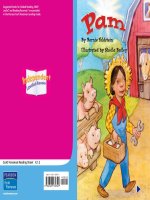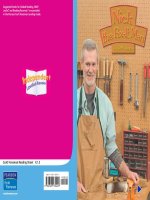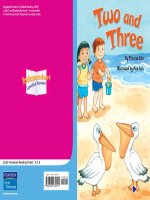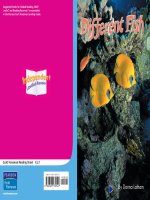science scott foresman a
Bạn đang xem bản rút gọn của tài liệu. Xem và tải ngay bản đầy đủ của tài liệu tại đây (28.2 MB, 320 trang )
xx
8dbeVgZVcY8dcigVhi
@
cdl^c\]dli]^c\hdgZkZcihVgZVa^`ZVcYY^[[ZgZciXVc]Zaendj
j
c
Y
ZghiVc
Y
i
]
ZhX^ZcXZndjgZV
Y
#L
]
Zcndj XdbeVgZild
^
iZbh!ndj
i
Zaa]dli]Z
n
VgZVa^`Z#L]Zc
n
dj XdcigVhi
i]Zb!ndjiZaa]dli]ZnVgZ
Y
^[[
Z
g
Z
ci
#
JhZ
i]
Z
dWhZgkVi^dch
Y
ZhXg^
W
Z
Y
^ci
]
ZhX^ZcXZ_djgcV
a
W
Z
a
dl
i
d
X
dbeVgZ
Vc
Y
Xdc
i
gVh
i
i
]
Z
a
ZVkZh#
H
X^ZcXZ?djgcVa
AZV[DWhZgkVi^dch
)
LOOKEDATTWODIFFERENTKINDSOFLEAVES"OTH
W
ERE
GREEN
A
N
D
H
AD
M
AN
Y
VE
I
N
S
RUNN
I
N
G
THROUGHOUT,EA
F
!WAS
O
VA
L
WIT
H
JAGGE
D
POINTS
AROUN
D
ITSE
D
GE
,EAF"WAS
L
ONGAN
D
NARROW
)TS
ED
G
ESWERESMOOTH
4H
E
SU
RF
ACE
O
F
BOT
HL
EA
V
ES
W
AS
S
M
OOTH
6ee
a
n>i
B
V`ZV\gV
e
]^Xdg\Vc^oZg
a
^
`
Zi
]
^hdcZ#8dbeVgZVc
Y
XdcigVhii
]
Z
a
ZVkZh^ci
]
Z
_djgcVaZcign#Lg^iZlVnh
i]
Vii
]
Z
a
ZV
k
ZhVgZV
a
^
`
Z^c
i
]ZXZciZg#I]Zc^ci]ZAZV
[
6
Wdm!iZaal]VibV`ZhAZV[6
Y
^[[
Z
g
Z
ci[g
d
bA
ZV
[7
#
>ci]
Z
A
ZV
[
7Wdm!iZaa]dlAZV
[
7
Y^[[Zgh[gdbAZV[6#
Target
Reading Skill
Each page
has one target
reading skill.
The reading skill
corresponds with
a process skill
in the Directed
Inquiry activity
on the facing
page. The
reading skill will
be useful as you
read science.
Real-World
Connection
Each page has
an example of
something you
might read. It
also connects
with the Directed
Inquiry activity.
Graphic
Organizer
A useful strategy
for understanding
anything you
read is to create
a graphic
organizer.
A graphic
organizer
can help you
think about the
information and
relate parts of
it to each other.
Each reading
skill has a
certain graphic
organizer.
A page like this one is toward the beginning of each chapter.
It shows you how to use a reading skill that will help you
understand what you read.
Before Reading
Before you read the chapter, read the Build Background page
and think about how to answer the question. Recall what you
already know as you answer the question. Work with a partner
to make a list of what you already know. Then read the How
to Read Science page.
28962_xx-xxi_FSD i 11/13/06 5:42:45 PM
7di]eaVcihVcY
Vc^bVah\^kZd[[
XVgWdcY^dm^YZ
Yjg^c\XZaajaVg
gZhe^gVi^dc#
8VgWdc9^dm^YZ·Dmn\Zc8nXaZ
9OUMAYHAVENOTICEDTHATTHEEQUATIONSFORPHOTOSYNTHESIS
ANDCELLULARRESPIRATIONLOOKALOTALIKE)NFACTLOOKATTHESETWO
EQUATIONSAGAIN
XVgWdcY^dm^YZlViZg
a^\]iZcZg\n
X]adgde]naa
\ajXdhZdmn\Zc
\ajXdhZdmn\ZcXVgWdcY^dm^YZlViZgZcZg\n
4HEPROCESSESAREALMOSTTHEREVERSEOFEACHOTHER4HEMATERIALS
PRODUCEDDURINGONEPROCESSARETHESAMEMATERIALSTHATARENEEDED
FORTHEOTHERPROCESS)NOTHERWORDSTHEYFORMACYCLE4OGETHER
PHOTOSYNTHESISANDCELLULARRESPIRATIONFORMTHECARBONDIOXIDEn
OXYGENCYCLE
4HECARBONDIOXIDEnOXYGENCYCLECANBESUMMARIZEDINTHISWAY
$AYANDNIGHTANIMALSBREATHEOXYGENFROMTHEAIR0LANTSTAKEIN
OXYGENANDCARBONDIOXIDETHROUGHTHEIRLEAVES$URINGRESPIRATION
BOTHPLANTSANDANIMALSUSEOXYGENTOCHANGEENERGYINFOODTO
ENERGYTHEYCANUSE4HEYGIVEOFFCARBONDIOXIDE0LANTSUSESOMEOF
THEENERGYANDCARBONDIOXIDETOPRODUCEMOREFOODANDOXYGENIN
THEPROCESSOFPHOTOSYNTHESIS4HECARBONDIOXIDEnOXYGENCYCLEASSURES
THATLIVINGTHINGSDONOTRUNOUTOFTHEOXYGENANDCARBONTHEYNEED
&# L]ViYdeaVcihcZZYidXVggndce]didhnci]Zh^h4
'# L]nYdbdhiaZVkZh]VkZbdgZhidbViVdci]ZadlZgZe^YZgb^h
i]Vcdci]ZjeeZgZe^YZgb^h4
(#
8dbeVgZVcY8dcigVhi=dlYdZhi]ZgdaZd[ZcZg\nY^[[Zg
^ce]didhnci]Zh^hVcYXZaajaVggZhe^gVi^dc4
HeZX^Zh6 HeZX^Zh7 HeZX^Zh8
HiZb
g^\^YVcY
higdc\
\gZZc!
ZVhnid
WZcY
g^\^YVcY
higdc\
;adlZgh nZh nZh cd
&'#8aVhh^[nI]ZiVWaZYZhXg^WZhi]gZZ
heZX^Zhd[eaVcih#8aVhh^[nZVX]heZX^ZhVh
VcVc\^dheZgbdgV\nbcdheZgbVcYVh
lddYndg]ZgWVXZdjh#
&(#
BdYZaBV`ZY^V\gVbhidh]dll]ZgZ
mnaZbVcYe]adZbVgZ[djcY^cgddihVcY
hiZbh#AVWZai]ZY^V\gVbhidh]dli]Z
[jcXi^dcd[ZVX]`^cYd[i^hhjZ#
8dbeVgZVcY
8dcigVhi
&)#BV`ZV\gVe]^Xdg\Vc^oZga^`Zi]Z
dcZh]dlcWZadl#Lg^iZi]ZaZiiZghd[
i]ZYZhXg^ei^dch^ci]ZXdggZXieVgihd[
i]ZY^V\gVbidXdbeVgZVcYXdcigVhi
e]didhnci]Zh^hVcYXZaajaVggZhe^gVi^dc#
6 gZaZVhZhdmn\Zc
7 egdYjXZhXVgWdcY^dm^YZ
8 dXXjgh^cb^idX]dcYg^V
9 dXXjgh^cX]adgdeaVhih
: eZg[dgbZYWneaVcih
; eZg[dgbZYWnVc^bVah
IZhiEgZe
8]ddhZi]ZaZiiZgi]ViWZhiXdbeaZiZhi]Z
hiViZbZcidgVchlZghi]ZfjZhi^dc#
&*#L]^X]d[i]Z[daadl^c\YZhXg^WZhXZaajaVg
gZhe^gVi^dc4
WgZV`hYdlc\ajXdhZ!egdYjXZh
dmn\Zc
WgZV`hYdlc\ajXdhZ!egdYjXZh
XVgWdcY^dm^YZ
WgZV`hYdlcXVgWdcY^dm^YZ!
egdYjXZhdmn\Zc
WgZV`hYdlcXVgWdcY^dm^YZ!
egdYjXZh\ajXdhZ
&+# L]Vi^h^ch^YZedaaZc4
Z\\h dkjaZh
hZZYh heZgb
&,# 6eaVcil^i]\gZZchiZbhi]Via^kZdcandcZ
hZVhdc^hV
lddYneaVci Xdc^[Zg
ijWZg ]ZgWVXZdjheaVci
&-# L]^X]d[i]Z[daadl^c\eaVcihegdYjXZh
hedgZhi]Vi\gdl^cidcZleaVcih4
[Zgc HXdiX]e^cZ
eZVX]igZZ \gVhh
&.#:meaV^cl]ni]ZVchlZgndjX]dhZ[dg
FjZhi^dc&-^hWZhi#;dgZVX]d[i]Z
VchlZghndjY^YcdiX]ddhZ!\^kZV
gZVhdcl]n^i^hcdii]ZWZhiX]d^XZ#
'%#
9ZhXg^ei^kZ
HjeedhZ ndjVgZ\d^c\ideaVcihdbZ
hZZYh^cndjg\VgYZc#Lg^iZVeVgV\gVe]
i]ViYZhXg^WZhi]ZXdcY^i^dchndjbjhi
Xdch^YZg^cdgYZg[dgndjghZZYhid
\Zgb^cViZ#
6a^`Z
8ZaajaVg
gZhe^gVi^dc
E]didhnci]Zh^h
xxi
After Reading
After you have read the chapter, think
about what you found out. Exchange
ideas with your partner. Compare
the list you made before you read
the chapter with what you learned
by reading it. Answer the questions
in the Chapter Review. One question
uses the reading target skill.
During Reading
As you read the lesson, use
the Checkpoint to check your
understanding. Some Checkpoints
ask you to use the reading
target skill.
These are the target reading skills with their graphic organizers.
Cause and Effect Draw Conclusions
Compare and Contrast Summarize
Sequence Main Idea
Predict
and Details
Graphic Organizers
28962_xx-xxi_FSD ii 11/13/06 5:43:01 PM
xxii
28962_xxii-xxvii_FSD i 11/13/06 5:58:34 PM
xxiii
28962_xxii-xxvii_FSD ii 11/13/06 5:58:38 PM
xxiv
28962_xxii-xxvii_FSD iii 11/13/06 5:58:42 PM
xxv
28962_xxii-xxvii_FSD iv 11/13/06 5:58:46 PM
xxvi
What material is
best for keeping
heat in water?
Ask a question.
You might have a question
about something you observe.
State your hypothesis.
A hypothesis is a possible
answer to your question.
If I wrap the jar in fake
fur, then the water will
stay warmer longer.
Identify and
control variables.
Variables are things
that can change. For
a fair test, you choose
just one variable to
change. Keep all other
variables the same.
Test other materials. Put the same
amount of warm water in other jars
that are the same size and shape.
Scientists use scientific methods as they work. Scientific methods are
organized ways to answer questions and solve problems. Scientific methods
include the steps shown here. Scientists might not use all the steps. They
might not use the steps in this order. You will use scientific methods when
you do the Full Inquiry activity at the end of each unit. You also will
use scientific methods when you do Science Fair Projects.
28962_xxii-xxvii_FSD v 11/13/06 5:58:51 PM
cientists know they must work safely
when doing experiments. You need to be
careful when doing science activities too.
Follow these safety rules.
• Read the activity carefully before you start.
• Listen to the teacher’s instructions.
Ask questions about things you do not
understand.
• Wear safety goggles when needed.
• Keep your work area neat and clean.
Clean up spills right away.
• Never taste or smell substances unless directed
to do so by your teacher.
• Handle sharp items and other equipment
carefully.
• Use chemicals carefully.
• Help keep plants and animals that you
use safe.
• Tell your teacher if there is an accident
or you see something that looks unsafe.
• Put materials away when you finish.
• Dispose of chemicals properly.
• Wash your hands well when you
are finished.
xxxii
28962_xxviii-xxxii_FSD v 11/13/06 6:13:41 PM
xxviii
A microscope uses a series
of lenses that make objects
appear larger. When you
change the combination and
position of lenses, you magnify
objects by different amounts.
A
hand lens makes objects
appear larger. A hand lens,
or magnifying glass, doesn’t
enlarge things as much as a
microscope does, but you can
easily carry a hand lens.
Graduated cylinders
and beakers can be used
to measure volume, or
the amount of space an
object takes up.
A meterstick or metric ruler is
used to measure length.
A meterstick is one meter long.
The stick is divided into smaller
units—usually centimeters
and millimeters.
A
stopwatch is a
watch with a hand
that can be stopped or
started. It can be used
for timing experiments.
cientists use many different kinds of tools.
Tools can make objects appear larger. They can
help you measure volume, temperature, length,
distance, and mass. Tools can help you figure out
amounts and analyze your data. Tools can also
help you find the latest scientific information.
28962_xxviii-xxxii_FSD i 11/13/06 6:12:25 PM
xxix
A thermometer is used to
measure the temperature of
an object. The liquid in the
thermometer expands when
it gets warmer and contracts
when it cools. This causes the
liquid to move up and down
the temperature scale. In the
Celsius scale, 0° represents
the freezing point of water,
and 100° represents the
boiling point of water.
Cameras can be used
to take pictures of objects.
Pictures help you record
and compare objects and
observe changes.
Scientists use
computers in
many ways, such as for collecting,
recording, and analyzing data.
A
balance is used to measure mass. To find the
mass of an object, add standard masses to the pan
opposite the pan holding the object. When the two
pans are at the same level, the sum of the standard
masses equals the mass of the object.
Computer-aided
design
is a way of
using a computer to
make plans such as
drawings for a new
machine or building.
28962_xxviii-xxxii_FSD ii 11/13/06 6:12:45 PM
xxx
A spring scale is used to
measure force. Because the
weight of an object is a
measure of the force of
gravity on the object,
you can use a spring
scale to measure
weight in grams.
Calculators make
analyzing data
easier and faster.
Tape recorders are used by scientists
to record and learn about sounds made
by organisms or objects.
Scientists use
barometers to
measure the air
pressure, which can
be a good indicator
of weather patterns.
Field guides are books that you might take into
the field to learn the details of objects that you are
observing, such as plants, animals, or stars.
28962_xxviii-xxxii_FSD iii 11/13/06 6:13:06 PM
xxxi
Binoculars have two
eyepieces that contain
lenses that magnify
objects. Binoculars allow
you to see the details of
objects that you wouldn’t
be able to see because
they are too far away,
such as birds in a tree.
An
anemometer
measures wind speed.
Some anemometers
also measure the
direction of the wind.
A
probe is an instrument used
for investigating hard-to-
reach objects or parts of
objects. A temperature probe is
a sticklike tool inserted into an
object to measure temperature. A
space probe explores planets and
other objects in space that people
cannot reach.
Scientists use
voltmeters to
measure the difference
in electrical charge
between two points
within a circuit.
28962_xxviii-xxxii_FSD iv 11/13/06 6:13:23 PM
where living things on
Earth live.
how Earth’s living things
are classifi ed.
1
28962_001-003_FSD 1 10/3/06 10:52:01 AM
2
biosphere
adaptation
nonvascular plant
The part of Earth that
can support living things
2
3
species
classifi cation
bacteria
fungivascular plant
biosphere page 7
adaptation page 8
species page 8
classifi cation
page 11
bacteria page 12
fungi page 12
vascular
plant
page 14
nonvascular
plant
page 14
Chapter 1
Vocabulary
4
Explore How are mushrooms different?
Scientists can tell one type of mushroom from another by studying
spore prints, the patterns and colors made by mushroom spores.
What to Do
Cut off the stem so the
mushroom lies flat. Place the
mushroom on the paper.
Materials
Cover the mushroom
with a cup and leave it
for 2 days.
Repeat steps 1 and 2
with 2 other kinds of
mushrooms.
After 2 days, remove the
cups. Carefully remove the
mushrooms.
Observe
the spore prints on
the paper.
Explain Your Results
1. How are the spore prints alike and different? Are the
prints a useful way to tell mushrooms apart? Explain.
2. How can you use a spore print to classify mushrooms?
3 kinds of mushrooms
plastic knife
white and black paper
3 cups
Spore prints can
help you
classify
mushrooms.
Your teacher will
tell you which color
of paper to use for
each mushroom.
28962_004_FSD 4 10/3/06 10:52:43 AM
5
Compare and Contrast
When you look at how things are alike and different, you are
comparing and contrasting. When comparing two items, tell how they
are alike. When contrasting, tell how items are different.
• Clue words and phrases such as similar, like, all, both, in the same way,
and as well as signal comparisons.
• Clue words such as different, unlike, in a different way, and in contrast
signal contrasts.
Clue words are marked in the article below.
Science Article
Fungi
Molds and mushrooms are two kinds of
fungi. Molds, such as the black, fuzzy mold
that grows on bread, are threadlike fungi. In
contrast, mushrooms are club fungi, fungi that
are somewhat umbrella shaped. Both molds and
mushrooms grow rootlike structures that often are
hidden underneath the ground. All fungi get their
food from other organisms.
Apply It!
Make a graphic organizer like
the one shown to
compare
and
contrast molds and
mushrooms. Then tell how
you would use the graphic
organizer to
classify molds
and mushrooms.
Molds MushroomsAlike
28962_005_FSD 1 11/8/06 7:03:33 PM
You are trudging along in the hot desert,
and a flash of bright yellow catches your
attention. A closer look reveals bright cactus
flowers. Suddenly you hear a rustling noise.
What is this shocking beauty among the
blossoms? A snake! What kind of snake is
this? How can you find out? Perhaps no one
has ever seen this type of snake before—you
may have discovered a new organism!
6
28962_006-009_FSD 1 11/8/06 7:03:46 PM
7
Lesson 1
Where on Earth
do organisms live?
Earth is home to millions of different living things. A large
number of living things have not yet been discovered.
The Biosphere
You probably know that living things are on almost every
type of land, and also deep in the oceans and high in Earth’s
atmosphere. You may think that the area where things live
is large. But if you could shrink Earth to the size of an apple,
the area in which things can live would be less than the
thickness of the apple’s skin.
The part of Earth that can support living things is called
the biosphere. Living things and their environments make
up the biosphere. The biosphere has many environments,
such as deserts, oceans, fields, beaches, backyards, and the
sidewalks of the busiest streets.
Organisms in the Biosphere
Scientists have discovered and named nearly two
million different organisms in Earth’s biosphere. Even so,
scientists think that millions more organisms have not
been discovered.
Why are so many living things still unknown? Some parts
of Earth have not been well studied. Earth’s deep oceans,
polar areas, dense rain forests, and vast deserts are just some
of the areas about which we still have a lot to learn. Also,
many of Earth’s organisms are very tiny and hard to find.
Each organism in the biosphere interacts with other
organisms and the environment to produce a web of
interactions. Humans, too, play an important part in this
changing web. Because all parts of the web are connected,
a small change in one part can produce a large change in
another part.
1.
What is the biosphere?
2.
Descriptive Write a paragraph
that describes an environment in your area. Name the
types of organisms that live there.
These colorful fungi are
well suited to grow on
the damp forest floor.
Determined dandelions
poke through this sidewalk.
Your neighborhood is also
part of the biosphere.
This blackside hawkfish
spends much of its time
motionless among the
coral. Coral are living
organisms. What you
usually see are coral
shells. The soft, living
body of the coral grows
inside holes in the shell.
28962_006-009_FSD 7 10/3/06 10:52:58 AM
8
Variety Among Living Things
If your class wrote the names of all the different
organisms each student knows, imagine how long
the list would be! But your list would be very small
compared to all the known organisms on our planet.
Earth has an amazing variety of living things.
These organisms have many different body plans
and structures. These differences make it possible for
organisms to live in almost every place on Earth.
Look at the plants and animals pictured on these pages.
They all are alike in some ways. For example, they are
made of cells, they require a source of energy, and they
reproduce. But these organisms are also very different.
The differences enable each kind of organism to survive
in its particular environment.
A characteristic that enables an organism to
survive and reproduce in its environment is called an
adaptation. For example, the spines of the cactus are
actually modified leaves. Their shape helps stop water
loss from the plant. They also protect the cactus from
being eaten. The thick, fleshy stems of a cactus can
store a lot of water—an important adaptation for
a plant that grows in such a dry environment.
As you look at the other pictures on these
pages, think about how each organism’s
adaptations help it survive in its
environment.
Groups of Organisms
Although there is great variety
among organisms, some groups of
organisms share many of the same
characteristics. These organisms may
be members of the same species.
A species is a group of very similar
organisms whose members can
mate with one another and produce
offspring that are able to produce
offspring. For example, the horses in
the photo are members of the same
species. Each species has a two-part
scientific name. The scientific name
for the horse is Equus caballus.
Each type of fish has a
mouth designed for its
own style of feeding. This
parrotfish scrapes algae off
the surrounding coral. Can
you see how it gets its name?
How do the adaptations of
this cactus help it survive?
The hard shells of these snails
help protect their soft bodies,
much the same as your skull
protects your brain.
keyword: adaptation
code: g6p8
28962_006-009_FSD 8 10/3/06 10:53:12 AM
9
1. Why haven’t scientists identified all species that live
today or lived in the past?
2. What is a species? What are some ways members of
a species differ?
3.
Expository Choose an organism
that you are familiar with. Describe its environment
and some of its adaptations. Tell how the organism’s
adaptations help it survive in its environment.
Like the horses below, individuals in the same species
often don’t look exactly alike. In fact, they can be
different in many ways, including size, color, and shape.
But they do share similar body plans and structures.
As you can see from the chart, the number of species
for different kinds of organisms is very large. The chart,
however, only includes the species that have been
identified and live today. Some scientists think that
99 percent of all species that have ever lived on Earth
no longer exist. Most of them have left no fossil evidence
that they lived.
Group
Number
of Living
Species
Vertebrates 42,000
Mammals 4,000
Birds 9,000
Reptiles 6,000
Amphibians 4,000
Fish 19,000
Invertebrates 980,000
Plants 248,000
What characteristics do
these horses share?
9
28962_006-009_FSD 4 11/8/06 7:04:09 PM
Kingdom
Phylum
Class
10
Lesson 2
How do scientists
group organisms?
Scientists sort organisms into groups with similar characteristics.
Grouping organisms makes studying them easier. Many scientists today
divide all Earth’s organisms into six main groups called kingdoms.
How Organisms Are Grouped
With so many kinds of organisms, how can scientists study them?
Think about how a music store organizes the CDs it sells. Most music
stores group together musicians that share certain characteristics.
Animals
The organisms shown here
are all members of the
animal kingdom. Animals
are multicellular organisms
that must obtain their food
by eating other organisms.
Insects
The insect class contains
only arthropods with bodies
that are divided into three
sections and that usually
have three pairs of legs at
the middle section.
Arthropods
Animals that belong to the
arthropod phylum share
these characteristics: jointed
legs, a body divided into
segments, and a hard outer
skeleton.
28962_010-013_FSD 10 11/8/06 7:12:49 PM
Species
Genus
11
A music store may sort the musicians by the type of music they
play. In a similar way, scientists group Earth’s many organisms by the
similarities of their characteristics. These similarities may or may not
be easily seen. The grouping of things according to their similarities is
called classification.
Throughout history, scientists have used different classification
systems. Even today, scientists do not agree on a single system.
However, most scientists today use a system similar to the one
developed by Carolus Linnaeus in the 1700s.
Linnaeus first grouped all organisms into two very large groups,
called kingdoms. These were the plant kingdom and the animal
kingdom. Then Linnaeus divided each kingdom into smaller
groups based on the features of the organisms. The most common
classification system scientists use today is based on six kingdoms,
which are divided into smaller and smaller groups. Study the pictures
below to see how many scientists today divide the animal kingdom.
1.
Why do scientists classify organisms?
2.
Scientists have discovered about 800,000
species of insects. But scientists think that there may be as many
as 10,000,000 insect species. What percentage of the total number
of insect species have been discovered?
Coleoptera
This order contains only
insects with two pairs of
wings that meet in a straight
line along the back. The
longer back wings are
under the front wings.
Coccinellidae
This family contains only
ladybug beetles. All
members are dome-shaped,
usually brightly colored
and spotted, have short
legs, and are less than one
centimeter long.
Coccinella novemnotata
Members of different species
in the same genus are very
similar but cannot mate with
one another. The red spotted
ladybug beetle belongs to
the genus Coccinella and the
species novemnotata.
Order
Family
28962_010-013_FSD 11 11/8/06 7:13:31 PM
12
Organisms in The Six Kingdoms
Linnaeus did not have the scientific tools that scientists have
today, such as powerful microscopes to study an organism’s
cells. As scientists developed new tools for studying organisms,
they recognized living things that didn’t fit into Linnaeus’s two
kingdoms —plants and animals. For example, scientists discovered
bacteria, single-celled organisms that do not have a nucleus.
Both plant and animal cells contain a nucleus. This important
difference caused many scientists to think that bacteria should be
grouped separately from plants or animals. Today most scientists
classify organisms according to their cell structure and how they
get food and reproduce.
Many scientists put organisms into six kingdoms. Kingdom
Archaebacteria includes bacteria that live where most other
organisms cannot—in water that has a lot of salt or is very hot.
The kingdom Eubacteria includes all other bacteria. They live in
almost every environment, including your body. In fact, there
are more bacteria in your mouth than there are people on Earth!
Protists and Fungi
The more than 200,000 known species of protists are mostly
one-celled organisms. Some scientists think that this kingdom
should be broken into smaller kingdoms. The cells of all protists
contain a nucleus.
Some protists are like animals. They get energy by eating
other organisms. The ameba is an example. Plantlike protists
contain chlorophyll that they use to make their own food during
photosynthesis. Algae are plantlike protists. Some protists are
like fungi. They grow in damp, nutrient-rich environments,
where they absorb food through their cell membranes.
Fungi are mostly many-celled organisms that often grow in
moist, dark places. Many give off chemicals that break down
the organisms on which they grow. In the process, fungi get
the nutrients they need. In two types of fungi, mushrooms and
molds, cells form threadlike strands called hyphae. The hyphae
take in the nutrients for the organism. Hyphae can form thick,
large mats. One single mushroom in Oregon has a web of
underground hyphae that spreads 2,200 acres. That’s the size of
1,665 football fields! Yeast cells, another kind of fungus that you
can see in the picture, are not connected by hyphae.
Many fungi look like plants and have cells similar to plants.
But plant cells contain chlorophyll, which plants use as they
make food. Fungi do not have chlorophyll. Instead they take in
nutrients from other organisms.
Yeasts are important fungi
used in the process of
making bread.
Like most fungi, this mold
absorbs nutrients from
other organisms—in this
case a strawberry.
28962_010-013_FSD 12 10/3/06 10:54:26 AM









